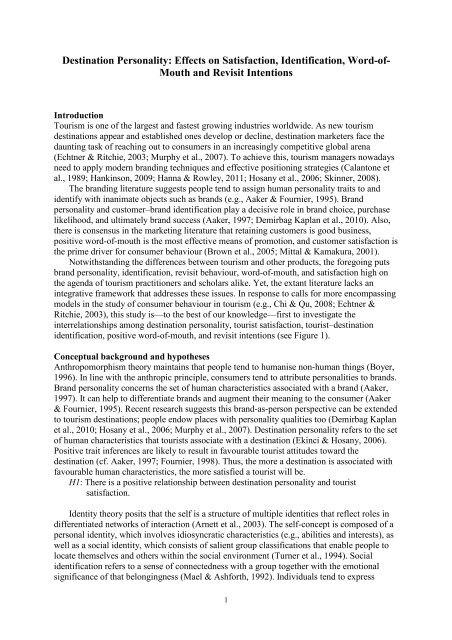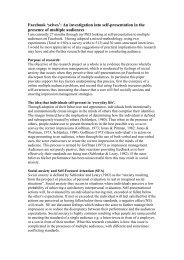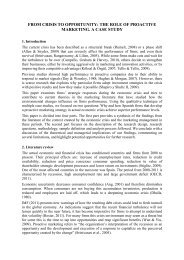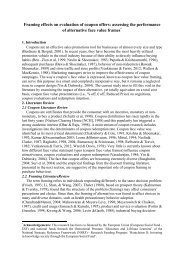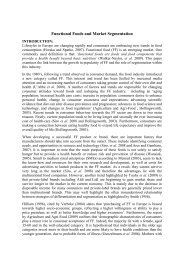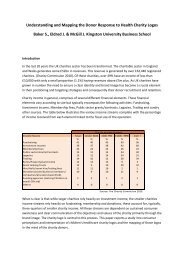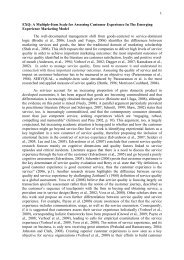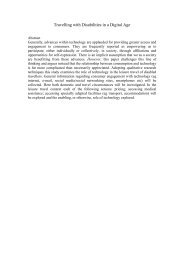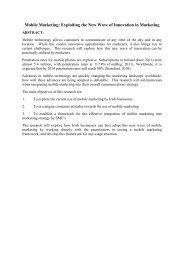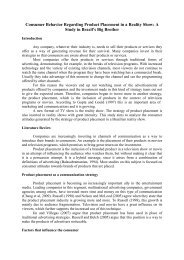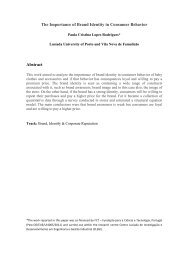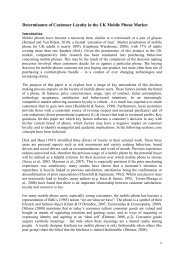Destination Personality: Effects on Satisfaction, Identification, Word-of
Destination Personality: Effects on Satisfaction, Identification, Word-of
Destination Personality: Effects on Satisfaction, Identification, Word-of
Create successful ePaper yourself
Turn your PDF publications into a flip-book with our unique Google optimized e-Paper software.
<str<strong>on</strong>g>Destinati<strong>on</strong></str<strong>on</strong>g> <str<strong>on</strong>g>Pers<strong>on</strong>ality</str<strong>on</strong>g>: <str<strong>on</strong>g>Effects</str<strong>on</strong>g> <strong>on</strong> Satisfacti<strong>on</strong>, Identificati<strong>on</strong>, <strong>Word</strong>-<strong>of</strong>-<br />
Mouth and Revisit Intenti<strong>on</strong>s<br />
Introducti<strong>on</strong><br />
Tourism is <strong>on</strong>e <strong>of</strong> the largest and fastest growing industries worldwide. As new tourism<br />
destinati<strong>on</strong>s appear and established <strong>on</strong>es develop or decline, destinati<strong>on</strong> marketers face the<br />
daunting task <strong>of</strong> reaching out to c<strong>on</strong>sumers in an increasingly competitive global arena<br />
(Echtner & Ritchie, 2003; Murphy et al., 2007). To achieve this, tourism managers nowadays<br />
need to apply modern branding techniques and effective positi<strong>on</strong>ing strategies (Calant<strong>on</strong>e et<br />
al., 1989; Hankins<strong>on</strong>, 2009; Hanna & Rowley, 2011; Hosany et al., 2006; Skinner, 2008).<br />
The branding literature suggests people tend to assign human pers<strong>on</strong>ality traits to and<br />
identify with inanimate objects such as brands (e.g., Aaker & Fournier, 1995). Brand<br />
pers<strong>on</strong>ality and customer–brand identificati<strong>on</strong> play a decisive role in brand choice, purchase<br />
likelihood, and ultimately brand success (Aaker, 1997; Demirbag Kaplan et al., 2010). Also,<br />
there is c<strong>on</strong>sensus in the marketing literature that retaining customers is good business,<br />
positive word-<strong>of</strong>-mouth is the most effective means <strong>of</strong> promoti<strong>on</strong>, and customer satisfacti<strong>on</strong> is<br />
the prime driver for c<strong>on</strong>sumer behaviour (Brown et al., 2005; Mittal & Kamakura, 2001).<br />
Notwithstanding the differences between tourism and other products, the foregoing puts<br />
brand pers<strong>on</strong>ality, identificati<strong>on</strong>, revisit behaviour, word-<strong>of</strong>-mouth, and satisfacti<strong>on</strong> high <strong>on</strong><br />
the agenda <strong>of</strong> tourism practiti<strong>on</strong>ers and scholars alike. Yet, the extant literature lacks an<br />
integrative framework that addresses these issues. In resp<strong>on</strong>se to calls for more encompassing<br />
models in the study <strong>of</strong> c<strong>on</strong>sumer behaviour in tourism (e.g., Chi & Qu, 2008; Echtner &<br />
Ritchie, 2003), this study is—to the best <strong>of</strong> our knowledge—first to investigate the<br />
interrelati<strong>on</strong>ships am<strong>on</strong>g destinati<strong>on</strong> pers<strong>on</strong>ality, tourist satisfacti<strong>on</strong>, tourist–destinati<strong>on</strong><br />
identificati<strong>on</strong>, positive word-<strong>of</strong>-mouth, and revisit intenti<strong>on</strong>s (see Figure 1).<br />
C<strong>on</strong>ceptual background and hypotheses<br />
Anthropomorphism theory maintains that people tend to humanise n<strong>on</strong>-human things (Boyer,<br />
1996). In line with the anthropic principle, c<strong>on</strong>sumers tend to attribute pers<strong>on</strong>alities to brands.<br />
Brand pers<strong>on</strong>ality c<strong>on</strong>cerns the set <strong>of</strong> human characteristics associated with a brand (Aaker,<br />
1997). It can help to differentiate brands and augment their meaning to the c<strong>on</strong>sumer (Aaker<br />
& Fournier, 1995). Recent research suggests this brand-as-pers<strong>on</strong> perspective can be extended<br />
to tourism destinati<strong>on</strong>s; people endow places with pers<strong>on</strong>ality qualities too (Demirbag Kaplan<br />
et al., 2010; Hosany et al., 2006; Murphy et al., 2007). <str<strong>on</strong>g>Destinati<strong>on</strong></str<strong>on</strong>g> pers<strong>on</strong>ality refers to the set<br />
<strong>of</strong> human characteristics that tourists associate with a destinati<strong>on</strong> (Ekinci & Hosany, 2006).<br />
Positive trait inferences are likely to result in favourable tourist attitudes toward the<br />
destinati<strong>on</strong> (cf. Aaker, 1997; Fournier, 1998). Thus, the more a destinati<strong>on</strong> is associated with<br />
favourable human characteristics, the more satisfied a tourist will be.<br />
H1: There is a positive relati<strong>on</strong>ship between destinati<strong>on</strong> pers<strong>on</strong>ality and tourist<br />
satisfacti<strong>on</strong>.<br />
Identity theory posits that the self is a structure <strong>of</strong> multiple identities that reflect roles in<br />
differentiated networks <strong>of</strong> interacti<strong>on</strong> (Arnett et al., 2003). The self-c<strong>on</strong>cept is composed <strong>of</strong> a<br />
pers<strong>on</strong>al identity, which involves idiosyncratic characteristics (e.g., abilities and interests), as<br />
well as a social identity, which c<strong>on</strong>sists <strong>of</strong> salient group classificati<strong>on</strong>s that enable people to<br />
locate themselves and others within the social envir<strong>on</strong>ment (Turner et al., 1994). Social<br />
identificati<strong>on</strong> refers to a sense <strong>of</strong> c<strong>on</strong>nectedness with a group together with the emoti<strong>on</strong>al<br />
significance <strong>of</strong> that bel<strong>on</strong>gingness (Mael & Ashforth, 1992). Individuals tend to express<br />
1
themselves by identifying with different social groupings, ranging from genetic features such<br />
as gender and ethnicity to brands and organisati<strong>on</strong>s (e.g., Fournier, 1998; Turner et al., 1994).<br />
Interestingly, a place may become a part <strong>of</strong> the self-c<strong>on</strong>cept in that it can evoke str<strong>on</strong>g<br />
cognitive and psychological attachments (Simps<strong>on</strong> & Siguaw, 2008). Tourist identificati<strong>on</strong><br />
with a destinati<strong>on</strong> refers to the extent to which a tourist perceives a sense <strong>of</strong> c<strong>on</strong>nectedness to<br />
a destinati<strong>on</strong> and defines him- or herself in terms <strong>of</strong> it (cf. Mael & Ashforth, 1992). Thus,<br />
destinati<strong>on</strong>s with a str<strong>on</strong>g pers<strong>on</strong>ality are likely to evoke tourist–destinati<strong>on</strong> identificati<strong>on</strong> by<br />
virtue <strong>of</strong> effectively reflecting tourists’ desired self-c<strong>on</strong>cepts.<br />
H2: There is a positive relati<strong>on</strong>ship between destinati<strong>on</strong> pers<strong>on</strong>ality and tourist–<br />
destinati<strong>on</strong> identificati<strong>on</strong>.<br />
Promoting is defined as providing positive informati<strong>on</strong> about a visited destinati<strong>on</strong> in<br />
social situati<strong>on</strong>s (cf. Arnett et al., 2003). Brand pers<strong>on</strong>ality can serve as a basis for<br />
differentiati<strong>on</strong> that <strong>of</strong>ten leads to favourable customer attitudes and behaviours toward the<br />
brand (e.g., Aaker, 1997; Brakus et al., 2009). Under this premise, tourists are likely to single<br />
out, speak highly <strong>of</strong>, and revisit destinati<strong>on</strong>s that possess a distinctive and favourable<br />
character (Chi & Qu, 2008; Ekinci & Hosany, 2006).<br />
H3: There is a positive relati<strong>on</strong>ship between destinati<strong>on</strong> pers<strong>on</strong>ality and promoting.<br />
H4: There is a positive relati<strong>on</strong>ship between destinati<strong>on</strong> pers<strong>on</strong>ality and revisit intenti<strong>on</strong>s.<br />
Satisfacti<strong>on</strong> may result in a re-evaluati<strong>on</strong> <strong>of</strong> the salience <strong>of</strong> identities in that positive<br />
feelings and emoti<strong>on</strong>s are important for the formati<strong>on</strong>, maintenance, and development <strong>of</strong><br />
identities (Arnett et al., 2003). By virtue <strong>of</strong> their positive affective state, satisfied tourists are<br />
likely to feel a deep rapport with the visited destinati<strong>on</strong> (Hou et al., 2005; Ryan, 1995) and<br />
create or reinforce their identity in relati<strong>on</strong> to it.<br />
H5: There is a positive relati<strong>on</strong>ship between tourist satisfacti<strong>on</strong> and tourist–destinati<strong>on</strong><br />
identificati<strong>on</strong>.<br />
Positive word-<strong>of</strong>-mouth originates from customer satisfacti<strong>on</strong>, especially in cases when<br />
experience surpasses expectati<strong>on</strong>s (Brown, 2005). It is therefore plausible that satisfied<br />
tourists will speak favourably <strong>of</strong> a visited destinati<strong>on</strong> to their circle <strong>of</strong> acquaintances up<strong>on</strong><br />
return (Weaver et al., 2007). Further, they are likely to revisit the destinati<strong>on</strong> (Chi and Qu,<br />
2008). This can be ascribed to risk minimising behaviour: given the c<strong>on</strong>siderable m<strong>on</strong>etary<br />
sacrifice incurred in tourist activities, people might be reluctant to take the risk <strong>of</strong> an unknown<br />
destinati<strong>on</strong> and opt for visiting <strong>on</strong>e they are already satisfied with (Alegre & Juaneda, 2006).<br />
H6: There is a positive relati<strong>on</strong>ship between tourist satisfacti<strong>on</strong> and promoting.<br />
H7: There is a positive relati<strong>on</strong>ship between tourist satisfacti<strong>on</strong> and revisit intenti<strong>on</strong>s.<br />
Individuals are likely to enact behaviours that they believe are c<strong>on</strong>sistent with a salient<br />
identity in that identities require self-expressi<strong>on</strong> (Arnett et al., 2003). Thus, tourists that foster<br />
str<strong>on</strong>g relati<strong>on</strong>al b<strong>on</strong>ds and identify with a destinati<strong>on</strong> are likely to exhibit higher tendencies<br />
to return there and ‘talk up’ this destinati<strong>on</strong> in c<strong>on</strong>versati<strong>on</strong>s with friends and acquaintances.<br />
H8: There is a positive relati<strong>on</strong>ship between tourist–destinati<strong>on</strong> identificati<strong>on</strong> and<br />
promoting.<br />
H9: There is a positive relati<strong>on</strong>ship between tourist–destinati<strong>on</strong> identificati<strong>on</strong> and revisit<br />
intenti<strong>on</strong>s.<br />
Method<br />
We approached a total <strong>of</strong> 746 postgraduate students <strong>on</strong> the campus <strong>of</strong> a large UK University<br />
and asked them whether they were willing to take part in a survey <strong>on</strong> their most recent<br />
overseas vacati<strong>on</strong>. We asked the resp<strong>on</strong>dents that showed interest to complete a self-<br />
2
administered questi<strong>on</strong>naire. A total <strong>of</strong> 529 postgraduates across a range <strong>of</strong> subjects agreed to<br />
participate (70.9%). We excluded 39 questi<strong>on</strong>naires from the analysis due to c<strong>on</strong>siderable<br />
missing data resulting in a total <strong>of</strong> 490 eligible resp<strong>on</strong>ses (92.6% <strong>of</strong> those students that agreed<br />
to participate). The descriptive statistics reveal that women (48.8%) and men (51.2%) almost<br />
equally comprised the study sample. The great majority were below 30 years <strong>of</strong> age (85.9%)<br />
and single (77.3%). Most resp<strong>on</strong>dents were Asian (38.4%) followed by UK (37.6%) and EU<br />
nati<strong>on</strong>als (13.9%). The resp<strong>on</strong>dents further reported that they had <strong>on</strong> average visited eight<br />
foreign countries and the majority (63.8%) visited the focal destinati<strong>on</strong> for the first time.<br />
Although student samples are not typically representative <strong>of</strong> the wider populati<strong>on</strong><br />
(Peters<strong>on</strong>, 2001), c<strong>on</strong>siderable empirical work suggests students can be as suitable<br />
participants as n<strong>on</strong>students in c<strong>on</strong>sumer behaviour studies. Prior research utilising student<br />
samples has yielded reliable findings (e.g., Bar<strong>on</strong>e et al., 2000; Sharma et al., 2010) and there<br />
is evidence to support a high corresp<strong>on</strong>dence between n<strong>on</strong>-student and student samples (e.g.,<br />
Palmatier et al., 2009; Völckner & Sattler, 2007). Also, students c<strong>on</strong>stitute a potentially<br />
lucrative segment for the tourism industry (e.g., Field, 1999; Gallarza & Saura, 2006; Litvin,<br />
2003). Hence, they are a relevant, appropriate, and important segment to investigate for the<br />
purposes <strong>of</strong> this study.<br />
We undertook an extensive review <strong>of</strong> the pertinent literature and a series <strong>of</strong> pers<strong>on</strong>al<br />
interviews to develop a draft questi<strong>on</strong>naire. Three academic researchers with a background in<br />
c<strong>on</strong>sumer behaviour and tourism evaluated the c<strong>on</strong>tent validity <strong>of</strong> the measures selected; they<br />
judged the extent to which each item represented the c<strong>on</strong>struct in questi<strong>on</strong> (Zaichkowsky,<br />
1985). We tested the revised questi<strong>on</strong>naire with five postgraduate students to ensure effective<br />
semantic design and instrument format and indentified no problems with respect to any <strong>of</strong> the<br />
measures or resp<strong>on</strong>se formats.<br />
We measured satisfacti<strong>on</strong> with six items (i.e., [<str<strong>on</strong>g>Destinati<strong>on</strong></str<strong>on</strong>g> Name (DN)] was a great<br />
destinati<strong>on</strong> to visit; during my visit to [DN], I accomplished the purpose <strong>of</strong> my vacati<strong>on</strong>; all<br />
things c<strong>on</strong>sidered (e.g., time, effort, m<strong>on</strong>ey), I am satisfied with my visit to [DN]; I have<br />
pleasant memories from my visit to [DN]; my visit to [DN] met my expectati<strong>on</strong>s; and <strong>on</strong> the<br />
whole, my choice to visit [DN] has been a wise <strong>on</strong>e) adapted from Gallarza and Saura (2006)<br />
and Lee et al. (2007). We measured identificati<strong>on</strong> with three items (i.e., [DN] fits well to me;<br />
I str<strong>on</strong>gly identify with [DN]; and I feel attached to [DN]) adapted from Homburg et al.<br />
(2009). We measured promoting with three items (i.e., I bring up [DN] in a positive way in<br />
c<strong>on</strong>versati<strong>on</strong>s I have with friends and acquaintances; I “talk up” [DN] to people I know; and<br />
in social situati<strong>on</strong>s, I <strong>of</strong>ten speak favourably about [DN]) adapted from Arnett et al. (2003).<br />
We anchored the resp<strong>on</strong>se formats for these c<strong>on</strong>structs by (1) “str<strong>on</strong>gly disagree” and (7)<br />
“str<strong>on</strong>gly agree.” We used a single-item (i.e., how likely is it that you would revisit [DN] in<br />
the near future) drawn from Yo<strong>on</strong> and Uysal (2005) to measure revisit intenti<strong>on</strong>s. Its resp<strong>on</strong>se<br />
format ranged from (-3) “very unlikely” to (+3) “very likely.” We operati<strong>on</strong>alised destinati<strong>on</strong><br />
pers<strong>on</strong>ality based <strong>on</strong> Aaker (1997) and Hosany et al. (2006) and used a rating scale ranging<br />
from (1) “not at all descriptive” to (7) “extremely descriptive.”<br />
In line with Podsak<strong>of</strong>f et al.’s (2003) recommendati<strong>on</strong>s for minimising comm<strong>on</strong> method<br />
bias (CMB) during the research design phase, we ensured resp<strong>on</strong>dents that there were no right<br />
or wr<strong>on</strong>g answers; used an<strong>on</strong>ymous self-completed questi<strong>on</strong>naires; employed different types<br />
<strong>of</strong> resp<strong>on</strong>se scale formats; did not group together most c<strong>on</strong>struct items by variable; and<br />
counterbalanced the order <strong>of</strong> some criteri<strong>on</strong> and predictor variables. We also c<strong>on</strong>ducted an ex<br />
post statistical analysis (discussed subsequently) to assess the possibility <strong>of</strong> CMB.<br />
Analysis and results<br />
We initially assessed and purified the scales through a combinati<strong>on</strong> <strong>of</strong> item-to-total<br />
correlati<strong>on</strong>s and exploratory factor analysis. The results <strong>of</strong> the factor analysis revealed that the<br />
3
items for satisfacti<strong>on</strong>, identificati<strong>on</strong>, promoting, and revisit intenti<strong>on</strong>s loaded str<strong>on</strong>gly <strong>on</strong> their<br />
corresp<strong>on</strong>ding factor (> .6). With respect to the destinati<strong>on</strong> pers<strong>on</strong>ality measures, the analysis<br />
revealed five factors with eigenvalues greater than 1. However, the scree test showed a<br />
significant dip between the sixth and seventh factor. This indicates that a six factor soluti<strong>on</strong><br />
explains the factor structure better. After eliminati<strong>on</strong> <strong>of</strong> items with low factor loadings and<br />
significant cross-loadings, a clean factor structure emerged explaining 70.1% <strong>of</strong> the total<br />
variance in destinati<strong>on</strong> pers<strong>on</strong>ality (see Table 1). We then derived meaning from the emergent<br />
factors in the c<strong>on</strong>text <strong>of</strong> tourism destinati<strong>on</strong>s and labelled them excitement, sophisticati<strong>on</strong>,<br />
activeness, dependability, philoxenia (a Greek word specific to the tourism industry; it means<br />
the opposite <strong>of</strong> xenophobia), and ruggedness.<br />
In order to establish c<strong>on</strong>vergent and discriminant validity, we subjected the retained set <strong>of</strong><br />
items to c<strong>on</strong>firmatory factor analysis and specifically ran two measurement models due to<br />
sample size restricti<strong>on</strong>s. The model results show a good fit to the data (see Table 2). Though<br />
the chi-square value are significant (χ 2 (60) = 141.52, p < .01), the other fit indices reveal a<br />
good fitting model (NFI = .99, NNFI = .99, CFI = .99, RMSEA = .053). We also estimated a<br />
sec<strong>on</strong>d-order model for destinati<strong>on</strong> pers<strong>on</strong>ality (Brakus et al., 2009). The results exhibit an<br />
acceptable model fit too (χ 2 (293) = 1029.12, p < .001, NFI = .95, NNFI = .96, CFI = .96,<br />
RMSEA = .072). All factor loadings <strong>of</strong> the items <strong>on</strong> their posited indicators exceed .58 and<br />
the t-values greater than 8.39 (p < .01), thus indicating c<strong>on</strong>vergent validity.<br />
We assessed discriminant validity through model comparis<strong>on</strong>s with φ freed versus fixed<br />
at <strong>on</strong>e for all c<strong>on</strong>struct pairs (Gerbing & Anders<strong>on</strong>, 1988). All ∆χ 2 are significant at the .05<br />
level. Further the variance shared between the latent c<strong>on</strong>structs is lower than the average<br />
variance extracted (AVE) for each individual c<strong>on</strong>struct, suggesting that the measures are not<br />
collinear (Fornell and Larcker, 1981). Table 3 presents the correlati<strong>on</strong>s, descriptive statistics,<br />
internal c<strong>on</strong>sistency estimates, and AVE for the study c<strong>on</strong>structs. We empirically tested for<br />
CMB in our data through Harman’s test: we estimated a single latent factor reflected by all<br />
the study’s manifest items (Podsak<strong>of</strong>f et al., 2003). The model statistics show a poor fit to the<br />
data (χ 2 (703) = 62330.50, p < .001; NFI= 0.83; NNFI= 0.84; CFI= 0.84; RMSEA= 0.42),<br />
suggesting that CMB is not a major issue.<br />
We then ran a structural model to test our hypothesised relati<strong>on</strong>ships. Given the sample<br />
size restricti<strong>on</strong>s, we used composite measures <strong>of</strong> the six destinati<strong>on</strong> pers<strong>on</strong>ality dimensi<strong>on</strong>s<br />
(see Brakus et al., 2009). The single-item c<strong>on</strong>struct revisit intenti<strong>on</strong>s was assumed to have a<br />
reliability <strong>of</strong> .90 for estimati<strong>on</strong> purposes (Anders<strong>on</strong> & Gerbing, 1988). The model fits the data<br />
well (χ 2 (144) = 335.23, p < .001, NFI = .99, NNFI = .99, CFI = .99, RMSEA = .052). Table 4<br />
shows the standardised parameter estimates, t-values, and significance levels for the<br />
hypothesised paths. The results suggest that, except for H7, the model links are all significant<br />
(p < .01) and in accordance with their respective hypotheses. Overall, the model explains a<br />
great amount (more than half) <strong>of</strong> the observed variance in the endogenous c<strong>on</strong>structs <strong>of</strong><br />
satisfacti<strong>on</strong> (60%), identificati<strong>on</strong> (57%), promoting (57%), and revisit intenti<strong>on</strong>s (52%).<br />
Discussi<strong>on</strong><br />
The findings reveal that although tourists appear to ascribe distinct pers<strong>on</strong>ality characteristics<br />
to tourism destinati<strong>on</strong>s, Aaker’s (1997) penta-factorial brand pers<strong>on</strong>ality structure is not fully<br />
applicable in this case (see also Demirbag Kaplan et al., 2010; Ekinci & Hosany, 2006; Ekinci<br />
et al., 2007; Murphy et al., 2007b). In our case, destinati<strong>on</strong> pers<strong>on</strong>ality can be portrayed in<br />
terms <strong>of</strong> the established characteristics excitement, sophisticati<strong>on</strong>, and ruggedness and the<br />
novel <strong>on</strong>es activeness, dependability, and philoxenia. The emergence <strong>of</strong> these tourismspecific<br />
pers<strong>on</strong>ality dimensi<strong>on</strong>s is not surprising c<strong>on</strong>sidering the idiosyncrasies <strong>of</strong> the tourism<br />
product <strong>of</strong>fering, which mainly delivers emoti<strong>on</strong>al experiences rather than tangible features.<br />
Interestingly, philoxenia has resemblance with the c<strong>on</strong>viviality dimensi<strong>on</strong> identified by<br />
4
Hosany et al. (2006). Further, we identified a shift <strong>of</strong> individual adjectives between<br />
pers<strong>on</strong>ality dimensi<strong>on</strong>s relative to Aaker’s (1997) scale. This was also the case in some prior<br />
research (e.g., Hosany et al., 2006; Murphy et al., 2007b). The phenomen<strong>on</strong> can be attributed<br />
to brand-adjective interacti<strong>on</strong>; individual words may assume varying meanings depending <strong>on</strong><br />
the type <strong>of</strong> product they are assigned to describe (Ekinci & Hosany, 2006). It appears that<br />
destinati<strong>on</strong> marketers need to c<strong>on</strong>sider tourism-specific traits when developing differentiated<br />
destinati<strong>on</strong> pers<strong>on</strong>alities. Clearly, more work is needed to refine and validate a pers<strong>on</strong>ality<br />
framework that is applicable across a wider range <strong>of</strong> tourism destinati<strong>on</strong>s.<br />
Further, the results suggest destinati<strong>on</strong> pers<strong>on</strong>ality is not <strong>on</strong>ly related to tourist<br />
satisfacti<strong>on</strong> and promoting, which is in line with previous research (see Ekinci & Hosany,<br />
2006) but also a prime determinant <strong>of</strong> revisit intenti<strong>on</strong>s. That destinati<strong>on</strong> pers<strong>on</strong>ality<br />
encourages tourist–destinati<strong>on</strong> identificati<strong>on</strong> is an important, fresh finding in the field.<br />
Marketers should bear this in mind when trying to craft destinati<strong>on</strong> pers<strong>on</strong>ality and attract<br />
c<strong>on</strong>gruent market segments.<br />
An intriguing result from this study is also what did not work: the direct impact <strong>of</strong><br />
satisfacti<strong>on</strong> <strong>on</strong> revisit intenti<strong>on</strong>s was not corroborated. While most work in tourism aligns to<br />
the general marketing literature and c<strong>on</strong>verges to the c<strong>on</strong>clusi<strong>on</strong> that satisfacti<strong>on</strong> results in<br />
return intenti<strong>on</strong>s (e.g., Chi & Qu, 2008; Um et al., 2006), some studies suggest this link does<br />
not always hold (e.g., Bigné et al., 2001). The explanati<strong>on</strong> for this may lie in the additi<strong>on</strong>al<br />
ramificati<strong>on</strong>s <strong>of</strong> the tourism c<strong>on</strong>text: people infrequently purchase vacati<strong>on</strong>s and novelty<br />
seeking is a key comp<strong>on</strong>ent driving tourist behaviour (Pearce & Kang, 2009). Nevertheless,<br />
under no circumstances should destinati<strong>on</strong> managers underestimate the importance <strong>of</strong> tourist<br />
satisfacti<strong>on</strong> given (1) its role as chief predictor <strong>of</strong> tourist–destinati<strong>on</strong> identificati<strong>on</strong> and<br />
promoting and (2) its indirect effects <strong>on</strong> revisit intenti<strong>on</strong>s via identificati<strong>on</strong>.<br />
Another finding <strong>of</strong> interest c<strong>on</strong>cerns the beneficial outcomes <strong>of</strong> identificati<strong>on</strong>. Tourists<br />
with str<strong>on</strong>g psychological attachments to a destinati<strong>on</strong> not <strong>on</strong>ly intend to revisit, but also<br />
serve as goodwill ambassadors. This is <strong>of</strong> vital importance for destinati<strong>on</strong> managers because<br />
positive word-<strong>of</strong>-mouth incurs no expenses and is far more credible and effective than<br />
marketer-sourced promoti<strong>on</strong>s (Simps<strong>on</strong> & Siguaw, 2008). Tourism scholars should take note<br />
that identificati<strong>on</strong> fulfils a self-definiti<strong>on</strong>al need and provides tourists with emoti<strong>on</strong>al returns<br />
(cf. Homburg et al., 2009) and can thus enhance understanding <strong>of</strong> tourist behaviour.<br />
Future studies could incorporate into the present model additi<strong>on</strong>al comp<strong>on</strong>ents <strong>of</strong><br />
c<strong>on</strong>sumer behaviour in tourism, such as motivati<strong>on</strong>s, normative influence, and self-c<strong>on</strong>strual.<br />
Also, an important directi<strong>on</strong> for further research is to explore the role <strong>of</strong> tourist experience in<br />
shaping destinati<strong>on</strong> pers<strong>on</strong>ality. It is hoped that this study will inspire further research <strong>on</strong> the<br />
interface between tourists and tourism destinati<strong>on</strong>s. Research al<strong>on</strong>g these lines is sorely<br />
needed.<br />
5
References<br />
Aaker, J.L. (1997), "Dimensi<strong>on</strong>s <strong>of</strong> Brand <str<strong>on</strong>g>Pers<strong>on</strong>ality</str<strong>on</strong>g>", Journal <strong>of</strong> Marketing Research, 34 3,<br />
347-356.<br />
Aaker, J.L. & Fournier, S. (1995), "The Brand as a Character, a Partner and a Pers<strong>on</strong>: Three<br />
Perspectives <strong>on</strong> the Questi<strong>on</strong> <strong>of</strong> Brand <str<strong>on</strong>g>Pers<strong>on</strong>ality</str<strong>on</strong>g>", Advances in C<strong>on</strong>sumer Research,<br />
22, 391-396.<br />
Alegre, J. & Juaneda, C. (2006), "<str<strong>on</strong>g>Destinati<strong>on</strong></str<strong>on</strong>g> Loyalty: C<strong>on</strong>sumers' Ec<strong>on</strong>omic Behavior",<br />
Annals <strong>of</strong> Tourism Research, 33(3), 684-706.<br />
Anders<strong>on</strong>, J.C. & Gerbing, D.W. (1988), "Structural Equati<strong>on</strong> Modeling in Practice: A<br />
Review and Recommended Two-Step Approach ", Psychological Bulletin, 103(3),<br />
411-423.<br />
Arnett, D.B., German, S.D. & Shelby, D.H. (2003), "The Identity Salience Model <strong>of</strong><br />
Relati<strong>on</strong>ship Marketing Success: The Case <strong>of</strong> N<strong>on</strong>pr<strong>of</strong>it Marketing", Journal <strong>of</strong><br />
Marketing, 67(2), 89-105.<br />
Bar<strong>on</strong>e, M.J., Miniard, P.W. & Romeo, J.B. (2000), "The Influence <strong>of</strong> Positive Mood <strong>on</strong><br />
Brand Extensi<strong>on</strong> Evaluati<strong>on</strong>s", Journal <strong>of</strong> C<strong>on</strong>sumer Research, 26(4), 386-400.<br />
Bigné, J.E., Sánchez, M.I. & Sánchez, J. (2001), "Tourism image, evaluati<strong>on</strong> variables and<br />
after purchase behaviour: inter-relati<strong>on</strong>ship", Tourism Management, 22(6), 607-616.<br />
Boyer, P. (1996), "What Makes Anthropomorphism Natural: Intuitive Ontology and Cultural<br />
Representati<strong>on</strong>s", Journal <strong>of</strong> the Royal Anthropological Institute, 2(1), 83-97.<br />
Brakus, J.J., Schmitt, B.H. & Zarant<strong>on</strong>ello, L. (2009), "Brand Experience: What Is It? How Is<br />
It Measured? Does It Affect Loyalty?", Journal <strong>of</strong> Marketing, 73(3), 52-68.<br />
Brown, H. 2005. Council <strong>of</strong> Graduate Schools Finds Decline in Internati<strong>on</strong>al Graduate<br />
Student Applicati<strong>on</strong>s for the Sec<strong>on</strong>d C<strong>on</strong>secutive Year: 1-2: Washingt<strong>on</strong> DC<br />
Brown, T.J., Barry, T.E., Dacin, P.A. & Gunst, R.F. (2005), "Spreading the <strong>Word</strong>:<br />
Investigating Antecedents <strong>of</strong> C<strong>on</strong>sumers' Positive <strong>Word</strong>-<strong>of</strong>-Mouth Intenti<strong>on</strong>s and<br />
Behaviors in a Retailing C<strong>on</strong>text", Journal <strong>of</strong> the Academy <strong>of</strong> Marketing Science,<br />
33(2), 123-138.<br />
Calant<strong>on</strong>e, R.J., Di Benedetto, C.A., Hakam, A. & Bojanic, D.C. (1989), "Multiple<br />
Multinati<strong>on</strong>al Tourism Positi<strong>on</strong>ing Using Corresp<strong>on</strong>dence Analysis", Journal <strong>of</strong><br />
Travel Research, 28(2), 25-32.<br />
Chi, C.G.-Q. & Qu, H. (2008), "Examining the structural relati<strong>on</strong>ships <strong>of</strong> destinati<strong>on</strong> image,<br />
tourist satisfacti<strong>on</strong> and destinati<strong>on</strong> loyalty: An integrated approach", Tourism<br />
Management, 29(4), 624-636.<br />
Demirbag Kaplan, M., Yurt, O., Guneri, B. & Kurtulus, K. (2010), "Branding places:<br />
applying brand pers<strong>on</strong>ality c<strong>on</strong>cept to cities", European Journal <strong>of</strong> Marketing,<br />
44(9/10), 1286-1304.<br />
Echtner, C.M. & Ritchie, J.R.B. (2003), "The Meaning and Measurement <strong>of</strong> <str<strong>on</strong>g>Destinati<strong>on</strong></str<strong>on</strong>g><br />
Image", Journal <strong>of</strong> Tourism Studies, 14(1), 37-48.<br />
Ekinci, Y. & Hosany, S. (2006), "<str<strong>on</strong>g>Destinati<strong>on</strong></str<strong>on</strong>g> <str<strong>on</strong>g>Pers<strong>on</strong>ality</str<strong>on</strong>g>: An Applicati<strong>on</strong> <strong>of</strong> Brand<br />
<str<strong>on</strong>g>Pers<strong>on</strong>ality</str<strong>on</strong>g> to Tourism <str<strong>on</strong>g>Destinati<strong>on</strong></str<strong>on</strong>g>s", Journal <strong>of</strong> Travel Research, 45(2), 127-139.<br />
Ekinci, Y., Sirakaya-Turk, E. & Baloglu, S. (2007), "Host Image and <str<strong>on</strong>g>Destinati<strong>on</strong></str<strong>on</strong>g><br />
<str<strong>on</strong>g>Pers<strong>on</strong>ality</str<strong>on</strong>g>", Tourism Analysis, 12(5-6), 433-446.<br />
Field, A.M. (1999), "The College Student Market Segment: A Comparative Study <strong>of</strong> Travel<br />
Behaviors <strong>of</strong> Internati<strong>on</strong>al and Domestic Students at a Southeastern University",<br />
Journal <strong>of</strong> Travel Research, 37(4), 375-381.<br />
Fornell, C. & Larcker, D.F. (1981), "Evaluating Structural Equati<strong>on</strong> Models with<br />
Unobservable Variables and Measurement Error ", Journal <strong>of</strong> Marketing Research,<br />
18(1), 39-50.<br />
6
Fournier, S. (1998), "C<strong>on</strong>sumer and their brands: Developing relati<strong>on</strong>ship theory in c<strong>on</strong>sumer<br />
research", Journal <strong>of</strong> C<strong>on</strong>sumer Research, 24(4), 343-373.<br />
Gallarza, M.G. & Saura, I.G. (2006), "Value dimensi<strong>on</strong>s, perceived value, satisfacti<strong>on</strong> and<br />
loyalty: an investigati<strong>on</strong> <strong>of</strong> university students’ travel behaviour", Tourism<br />
Management, 27(3), 437-452.<br />
Gerbing, D.W. & Anders<strong>on</strong>, J.C. (1988), "An Updated Paradigm for Scale Development<br />
Incorporating Unidimensi<strong>on</strong>ality and Its Assessment", Journal <strong>of</strong> Marketing Research,<br />
25(2), 186-192.<br />
Hankins<strong>on</strong>, G. (2009) “Managing destinati<strong>on</strong> brands: establishing a theoretical foundati<strong>on</strong>”,<br />
Journal <strong>of</strong> Marketing Management, 25(1-2), 97-115.<br />
Hanna, S. & Rowley J. (2011), “Towards a strategic place brand-management model”,<br />
Journal <strong>of</strong> Marketing Management, 27(5-6), 458-476.<br />
Homburg, C., Wieseke, J. & Hoyer, W.D. (2009), "Social Identity and the Service-Pr<strong>of</strong>it<br />
Chain", Journal <strong>of</strong> Marketing, 73(2), 38-54.<br />
Hosany, S., Ekinci, Y. & Uysal, M. (2006), "<str<strong>on</strong>g>Destinati<strong>on</strong></str<strong>on</strong>g> image and destinati<strong>on</strong> pers<strong>on</strong>ality:<br />
An applicati<strong>on</strong> <strong>of</strong> branding theories to tourism places", Journal <strong>of</strong> Business Research,<br />
59(5), 638-642.<br />
Hou, J.-S., Lin, C.-H. & Morais, D.B. (2005), "Antecedents <strong>of</strong> Attachment to a Cultural<br />
Tourism <str<strong>on</strong>g>Destinati<strong>on</strong></str<strong>on</strong>g>: The Case <strong>of</strong> Hakka and N<strong>on</strong>-Hakka Taiwanese Visitors to Pei-<br />
Pu, Taiwan", Journal <strong>of</strong> Travel Research, 44(2), 221-233.<br />
Lee, C.-K., Yo<strong>on</strong>, Y.-S. & Lee, S.-K. (2007), "Investigating the relati<strong>on</strong>ships am<strong>on</strong>g<br />
perceived value, satisfacti<strong>on</strong>, and recommendati<strong>on</strong>s: The case <strong>of</strong> the Korean DMZ",<br />
Tourism Management, 28(1), 204-214.<br />
Litvin, S.W. (2003), "Tourism and understanding: The MBA Study Missi<strong>on</strong>", Annals <strong>of</strong><br />
Tourism Research, 30(1), 77-93.<br />
Mael, F. & Ashforth, B.E. (1992), "Alumni and Their Alma Mater: A Partial Test <strong>of</strong> the<br />
Reformulated Model <strong>of</strong> Organizati<strong>on</strong>al Identificati<strong>on</strong>", Journal <strong>of</strong> Organizati<strong>on</strong>al<br />
Behavior, 13(2), 103-123.<br />
Mittal, V. & Kamakura, W.A. (2001), "Satisfacti<strong>on</strong>, Repurchase Intent, and Repurchase<br />
Behavior: Investigating the Moderating Effect <strong>of</strong> Customer Characteristics", Journal<br />
<strong>of</strong> Marketing Research, 38(1), 131-142.<br />
Murphy, L., Moscardo, G. & Benckendorff, P. (2007), "Using Brand <str<strong>on</strong>g>Pers<strong>on</strong>ality</str<strong>on</strong>g> to<br />
Differentiate Regi<strong>on</strong>al Tourism <str<strong>on</strong>g>Destinati<strong>on</strong></str<strong>on</strong>g>s", Journal <strong>of</strong> Travel Research, 46(1), 5-<br />
14.<br />
Palmatier, R.W., Jarvis, C.B., Bechk<strong>of</strong>f, J.R. & Kardes, F.R. (2009), "The Role <strong>of</strong> Customer<br />
Gratitude in Relati<strong>on</strong>ship Marketing", Journal <strong>of</strong> Marketing, 73(5), 1-18.<br />
Pearce, P.L. & Kang, M.-H. (2009), "The <str<strong>on</strong>g>Effects</str<strong>on</strong>g> <strong>of</strong> Prior and Recent Experience <strong>on</strong><br />
C<strong>on</strong>tinuing Interest in Tourist Settings", Annals <strong>of</strong> Tourism Research, 36(2), 172-190.<br />
Peters<strong>on</strong>, R.A. (2001), "On the Use <strong>of</strong> College Students in Social Science Research: Insights<br />
from a Sec<strong>on</strong>d-Order Meta-Analysis", Journal <strong>of</strong> C<strong>on</strong>sumer Research, 28(3), 450-461.<br />
Podsak<strong>of</strong>f, P.M., MacKenzie, S.B., Lee, J.-Y. & Podsak<strong>of</strong>f, N.P. (2003), "Comm<strong>on</strong> Method<br />
Biases in Behavioral Research: A Critical Review <strong>of</strong> the Literature and Recommended<br />
Remedies", Journal <strong>of</strong> Applied Psychology, 88(5), 879-903.<br />
Ryan, C. (1995), "Learning about tourists from c<strong>on</strong>versati<strong>on</strong>s: the over-55s in Majorca",<br />
Tourism Management, 16(3), 207-215.<br />
Sharma, P., Marshall, R., Reday, P.A. & Na W. (2010) "Complainers versus n<strong>on</strong>-complainers:<br />
a multi-nati<strong>on</strong>al investigati<strong>on</strong> <strong>of</strong> individual and situati<strong>on</strong>al influences <strong>on</strong> customer<br />
complaint behaviour”, Journal <strong>of</strong> Marketing Management, 26(1-2), 163-180.<br />
Simps<strong>on</strong>, P.M. & Siguaw, J.A. (2008), "<str<strong>on</strong>g>Destinati<strong>on</strong></str<strong>on</strong>g> <strong>Word</strong> <strong>of</strong> Mouth: The Role <strong>of</strong> Traveler<br />
Type, Residents, and Identity Salience", Journal <strong>of</strong> Travel Research, 47(2), 167-182.<br />
7
Skinner, H. (2008) “The emergence and development <strong>of</strong> place marketing’s c<strong>on</strong>fused identity”,<br />
Journal <strong>of</strong> Marketing Management, 24(9-10), 915-928.<br />
Turner, J.C., Oakes, P.J., Haslam, S.A. & McGarty, C. (1994), "Self and Collective:<br />
Cogniti<strong>on</strong> and Social C<strong>on</strong>text", Pers<strong>on</strong>al Social Psychology Bulletin, 20(5), 454-463.<br />
Um, S., Ch<strong>on</strong>, K. & Ro, Y. (2006), "Antecedents <strong>of</strong> revisit intenti<strong>on</strong>", Annals <strong>of</strong> Tourism<br />
Research, 33(4), 1141-1158.<br />
Völckner, F. & Sattler, H. (2007), "Empirical generalizability <strong>of</strong> c<strong>on</strong>sumer evaluati<strong>on</strong>s <strong>of</strong><br />
brand extensi<strong>on</strong>s", Internati<strong>on</strong>al Journal <strong>of</strong> Research in Marketing, 24(2), 149-162.<br />
Weaver, P.A., Weber, K. & McCleary, K.W. (2007), "<str<strong>on</strong>g>Destinati<strong>on</strong></str<strong>on</strong>g> Evaluati<strong>on</strong>: The Role <strong>of</strong><br />
Previous Travel Experience and Trip Characteristics", Journal <strong>of</strong> Travel Research,<br />
45(3), 333-344.<br />
Yo<strong>on</strong>, Y. & Uysal, M. (2005), "An examinati<strong>on</strong> <strong>of</strong> the effects <strong>of</strong> motivati<strong>on</strong> and satisfacti<strong>on</strong><br />
<strong>on</strong> destinati<strong>on</strong> loyalty: a structural model", Tourism Management, 26(1), 45-56.<br />
Zaichkowsky, J.L. (1985), "Measuring the Involvement C<strong>on</strong>struct", Journal <strong>of</strong> C<strong>on</strong>sumer<br />
Research, 12(3), 341-352.<br />
8
Appendices<br />
Figure 1: Research model<br />
H 1 (+)<br />
<str<strong>on</strong>g>Destinati<strong>on</strong></str<strong>on</strong>g> H3 (+)<br />
<str<strong>on</strong>g>Pers<strong>on</strong>ality</str<strong>on</strong>g><br />
H 2 (+)<br />
H 3 (+)<br />
H 4 (+)<br />
Tourist<br />
Satisfacti<strong>on</strong><br />
H 5 (+)<br />
Tourist-<br />
<str<strong>on</strong>g>Destinati<strong>on</strong></str<strong>on</strong>g><br />
Identificati<strong>on</strong><br />
9<br />
H 7 (+)<br />
H 9 (+)<br />
H 6 (+)<br />
H 8 (+)<br />
Promoting<br />
Revisit<br />
Intenti<strong>on</strong>s
Table 1: Exploratory factor analysis for destinati<strong>on</strong> pers<strong>on</strong>ality a<br />
<str<strong>on</strong>g>Destinati<strong>on</strong></str<strong>on</strong>g><br />
pers<strong>on</strong>ality traits<br />
Factor 1<br />
Excitement<br />
Factor 2<br />
Sophisticati<strong>on</strong><br />
Factor 3<br />
Activeness<br />
10<br />
Factor 4<br />
Dependability<br />
Factor 5<br />
Philoxenia<br />
Factor 6<br />
Ruggedness<br />
Charming .712 .179 .112 .197 .282 -.016<br />
Original .702 .131 .210 .335 .029 .102<br />
Imaginative .701 .203 .162 .152 .200 .173<br />
Exciting .694 .203 .356 .056 .174 .195<br />
Unique .608 .295 .275 .117 .141 .150<br />
Spirited .603 .182 .296 .090 .157 .213<br />
Upper-class .081 .852 .055 .120 .022 .068<br />
Glamorous .243 .837 .115 -.004 .092 .052<br />
Elegant .318 .779 -.009 .168 .059 .076<br />
Sophisticated .180 .700 .179 .248 .114 .079<br />
Trendy .075 .670 .420 .005 .150 .083<br />
Energetic .332 .135 .782 .188 .256 .159<br />
Active .276 .124 .776 .207 .191 .147<br />
Dynamic .331 .227 .659 .172 .086 .237<br />
Lively .413 .180 .601 .100 .369 .144<br />
Reliable .286 .163 .151 .734 .105 -.059<br />
Resp<strong>on</strong>sible .012 .213 .327 .696 .102 .260<br />
Stable .023 .319 .254 .670 .029 .141<br />
Sincere .426 .031 -.005 .640 .234 .173<br />
H<strong>on</strong>est .298 -.125 -.073 .637 .326 .193<br />
Funny .100 .109 .253 .093 .803 .040<br />
Warm .291 .086 .099 .220 .722 .072<br />
Cheerful .421 .181 .263 .211 .661 .018<br />
Tough .119 .088 .104 .135 -.011 .864<br />
Rugged .172 -.022 .104 .113 .149 .758<br />
Bold .164 .299 .306 .139 -.021 .679<br />
Eigenvalues 10.43 2.34 1.74 1.59 1.19 .94<br />
% <strong>of</strong> Variance 40.11 9.00 6.71 6.13 4.57 3.60<br />
KMO = .92, Bartlett’s test: χ 2 (325) = 7899.82, p < .01<br />
a Varimax rotati<strong>on</strong> c<strong>on</strong>verging in 7 iterati<strong>on</strong>s
Table 2: Measurement models<br />
Measurement model 1 Measurement model 2<br />
First-order c<strong>on</strong>struct measurement summary:<br />
C<strong>on</strong>firmatory factor analysis<br />
Factors and items<br />
Standardised<br />
loadings<br />
t-values<br />
11<br />
<str<strong>on</strong>g>Destinati<strong>on</strong></str<strong>on</strong>g> pers<strong>on</strong>ality measurement summary:<br />
Sec<strong>on</strong>d-order c<strong>on</strong>firmatory factor analysis<br />
Factors and items<br />
Standardised<br />
loadings<br />
t-values<br />
Satisfacti<strong>on</strong> First-Order Factors<br />
Sat1 .83 18.50 Excitement<br />
Sat2 .89 20.44 Exc1 a .64 —<br />
Sat3 .87 19.86 Exc2 .72 12.48<br />
Sat4 .90 20.98 Exc3 .79 13.56<br />
Sat5 .88 20.26 Exc4 .87 14.57<br />
Sat6 .85 19.21 Exc5 .74 14.44<br />
Exc6 .82 13.88<br />
Identificati<strong>on</strong> Sophisticati<strong>on</strong><br />
Id1 .81 17.46 Soph1 a .68 —<br />
Id2 .89 19.91 Soph2 .68 10.72<br />
Id3 .79 16.81 Soph3 .79 11.99<br />
Soph4 .86 12.73<br />
Promoting Soph5 .81 12.28<br />
Pr1 .78 16.39 Activeness<br />
Pr1 .90 20.12 Act1 a .75 —<br />
Pr1 .83 17.73 Act2 .87 17.86<br />
Act3 .95 19.42<br />
Revisit intenti<strong>on</strong>s Act4 .80 16.03<br />
Rev1 .98 24.26 Dependability<br />
Dep1 a .67 —<br />
Dep2 .78 12.67<br />
Dep3 .73 11.95<br />
Dep4 .68 11.38<br />
Dep5 .61 10.33<br />
Philoxenia<br />
Ph1 a .66 —<br />
Ph2 .72 11.96<br />
Ph3 .91 13.43<br />
Ruggedness<br />
Rug1 a .64 —<br />
Rug2 .78 10.91<br />
Rug3 .77 10.89<br />
Fit indices: χ 2 (60) = 141.52, p < .001, NFI = .99,<br />
NNFI = .99, CFI = .99, RMSEA = .053<br />
a<br />
Item fixed to set the scale.<br />
Sec<strong>on</strong>d-Order Factor<br />
<str<strong>on</strong>g>Destinati<strong>on</strong></str<strong>on</strong>g> pers<strong>on</strong>ality<br />
Excitement .92 14.27<br />
Sophisticati<strong>on</strong> .60 9.48<br />
Activeness .83 13.61<br />
Dependability .75 10.77<br />
Philoxenia .79 11.01<br />
Ruggedness .58 8.39<br />
Fit indices: χ 2 (293) = 1029.12, p < .001, NFI = .95,<br />
NNFI = .96, CFI = .96, RMSEA = .072
Table 3: Correlati<strong>on</strong>s and measurement statistics<br />
Measures X1 X2 X3 X4 X5<br />
<str<strong>on</strong>g>Destinati<strong>on</strong></str<strong>on</strong>g> pers<strong>on</strong>ality X1 1.00<br />
Satisfacti<strong>on</strong> X2 .67* 1.00<br />
Identificati<strong>on</strong> X3 .60* .63* 1.00<br />
Promoting X4 .58* .59* .61* 1.00<br />
Revisit intenti<strong>on</strong>s X5 .52* .53* .51* .43* 1.00<br />
x 4.78 5.51 4.74 4.67 5.13<br />
SD .93 1.46 1.47 1.49 1.80<br />
α .85 .94 .86 .86 -<br />
ρ .80 .90 .79 .79 -<br />
AVE .50 .76 .69 .70 -<br />
* p < .01.<br />
12
Table 4: Structural equati<strong>on</strong> model results<br />
Hypotheses Standardised loadings t-values<br />
<str<strong>on</strong>g>Destinati<strong>on</strong></str<strong>on</strong>g> pers<strong>on</strong>ality → Satisfacti<strong>on</strong> .78 10.44*<br />
<str<strong>on</strong>g>Destinati<strong>on</strong></str<strong>on</strong>g> pers<strong>on</strong>ality → Identificati<strong>on</strong> .41 5.18*<br />
<str<strong>on</strong>g>Destinati<strong>on</strong></str<strong>on</strong>g> pers<strong>on</strong>ality → Promoting .27 3.34*<br />
<str<strong>on</strong>g>Destinati<strong>on</strong></str<strong>on</strong>g> pers<strong>on</strong>ality → Revisit intenti<strong>on</strong>s .31 3.15*<br />
Satisfacti<strong>on</strong> → Identificati<strong>on</strong> .39 5.38*<br />
Satisfacti<strong>on</strong> → Promoting .20 2.65*<br />
Satisfacti<strong>on</strong> → Revisit intenti<strong>on</strong>s .17 1.89<br />
Identificati<strong>on</strong> → Promoting .36 4.99*<br />
Identificati<strong>on</strong> → Revisit intenti<strong>on</strong>s .31 3.58*<br />
Fit Indices: χ 2 (144) = 335.23, p < .001, NFI = .99, NNFI = .99, CFI = .99, RMSEA = .052<br />
*p < .01<br />
13


